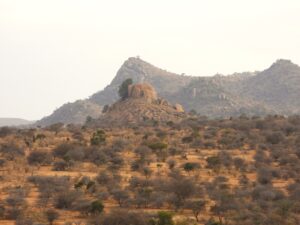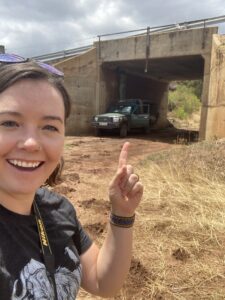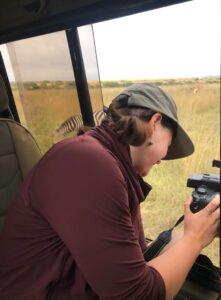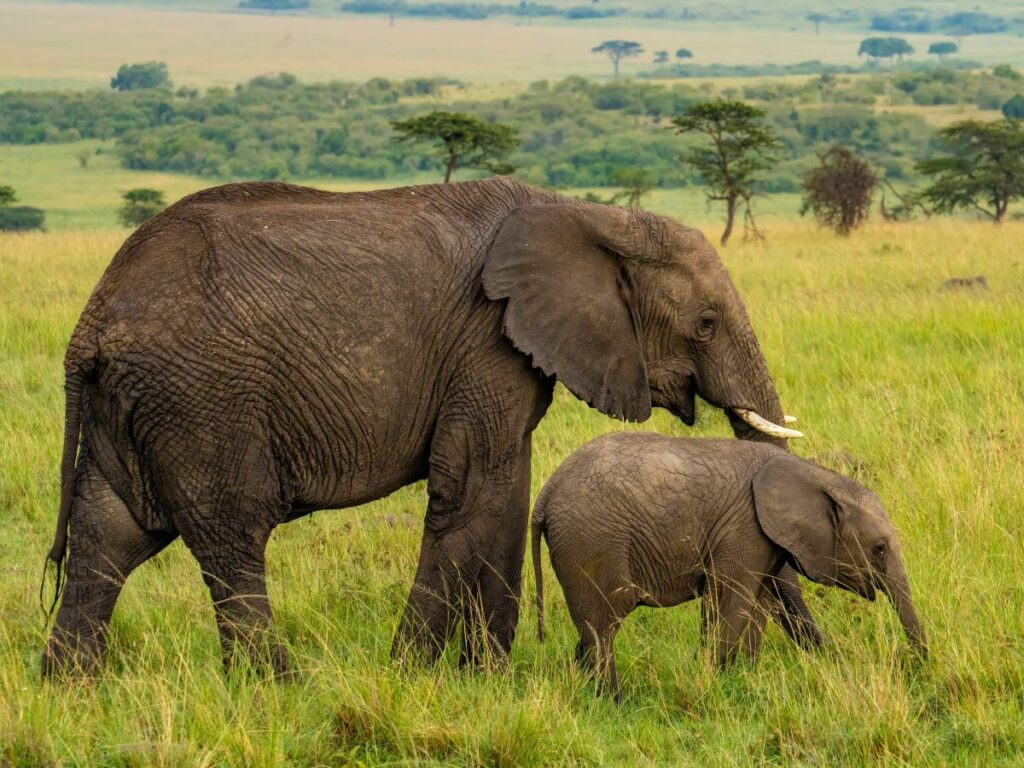by Melissa Butynski

The last time I was in Kenya, I flew home to the U.S. on March 3, 2020, blissfully unaware that the entire world was about to upend itself due to COVID-19. I had been living in Kisumu full-time, finishing my Master of Environmental Management degree, and only expected to spend three months in the U.S. for a short-term consulting gig and graduation. But those few months turned into a long-term move back and I secured a role with the Center for Large Landscape Conservation.
Over three years later, I finally found myself back on Kenyan soil, looking forward to visiting family, meeting colleagues outside a Zoom screen, and attending the African Congress on Linear Infrastructure and Ecology. I spent the first few days in the country visiting family and spending time deep in the bush a few hours away from the stoic Mount Kenya. The evidence of drought was prevalent across the landscape, with dusty, bare ground and a startling lack of livestock.
Despite the harsh conditions, daily drives to view wildlife offered incredible sights, from hyenas cooling off in the river, to elephants ambling among the brush, and even a quick glimpse of two leopards searching for a cool spot to beat the day’s heat. I was lucky enough to be present for the first rain of the season, a heavy deluge that swept across the landscape, muting the heat and beating down the persistent red dust. I’ll be honest: the band Toto was really on to something.
Kenya’s Famous Elephant Underpass

After a few days with friends and family, I headed further north to visit the incomparable landscape of Lewa Wildlife Conservancy. Between meetings, I was afforded the incredible opportunity to join Lewa staff on a visit to the first elephant underpass constructed in East Africa. The underpass offers elephant-safe passage beneath the bustling Nanyuki-Meru A2 Highway. I’ve driven over this structure innumerable times, so the opportunity to inspect it up close was an incredible treat.
Constructed in 2010, the underpass facilitates wildlife movement between the highlands of Mount Kenya and the Ngare Ndare Forest Reserve and is often referred to as the Mount Kenya Elephant Corridor. Since the first elephant pioneered its way through the structure on January 1, 2011, the Lewa team has continued monitoring the underpass’s usage through two camera traps mounted to the structure’s ceiling.
While the team downloaded photos from the camera trap memory cards and replaced batteries, I wandered through the structure, looking at footprints in the dirt indicating that elephants, lions, and various ungulates had recently utilized the structure. Despite my high hopes, we saw no actual wildlife nearby, but I was able to capture some incredible photos of elephant footprints leading through the structure and imagined that the prints could have represented a deadly collision averted.
Engaging with Partners to Protect Elephant Movement

Infrastructure remained the theme of the rest of my time in Kenya. My colleague Megan Parker joined me and attended the African Congress on Linear Infrastructure and Ecology. We were able to engage with global participants and learn more about the state of infrastructure ecology, or the study of interactions between nature and the built environment. I facilitated a workshop entitled ‘Cross-Continental Pachyderm Practices: Sharing Best Solutions for Elephant-Friendly Linear Infrastructure,’ which featured the work of the Asian Elephant Transport Working Group. It was an exciting opportunity to present on the upcoming Handbook of Mitigation Measures to Protect Asian Elephants from Linear Transport Infrastructure to African specialists and see if a similar guidance could be useful in the African context. Megan also presented on the Center for Large Landscape Conservation’s recently completed A.P.E. Project.
We also had the chance to visit Nairobi National Park for the day, where we finally saw the infamous Standard Gauge Railway, which now traverses the park. Want to learn more about this example of the government endorsing requirements for public participation but failing to heed public concern? In that case, I encourage you to see the recently published Technical Report, ‘Addressing Ecological Connectivity in the Development of Roads, Railways, and Canals’, Box 8.
 Zebra and elevated train tracks |  Elephant and linear infrastructure |  Spotted hyena |
The opportunity to return to Kenya after my rapid departure in 2020 was incredible. However, even more incredible was the opportunity to finally engage with the Center’s on-the-ground partners and colleagues, who are all doing some amazing work to connect and protect the landscapes of East Africa. I’m thrilled to be able to continue my work in this region, be it via zoom or in person, as we move conservation goals forward together! Pamoja means “together” in Swahili, and I think this people-centered lens is a leading quality of the work being done by the Center.
Melissa Butynski is the International Connectivity Project Specialist at the Center for Large Landscape Conservation. She combines her wildlife biology and project management background to provide research expertise and leadership for projects within the International Connectivity Program. She also serves as the coordinator for the IUCN Asian Elephant Transport Working Group.
Photo, top: African Elephant Mother And Calf Maasai Mara Reserve Kenya – Adobe Stock. All other photos by Melissa Butynski.



